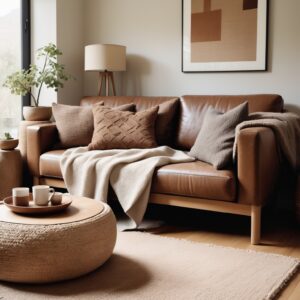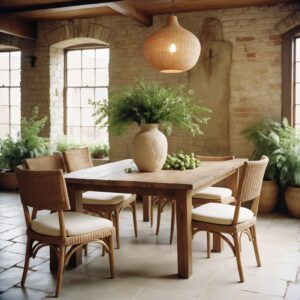When it comes to creating an inviting and visually appealing interior, texture is an essential yet often overlooked element. Unlike color or shape, texture has a more subtle, tactile quality that can transform a space from bland to extraordinary. In this blog post, we’ll delve into the importance of texture in interior design, explore different types of textures, and provide practical tips for incorporating texture into your home.
The Importance of Texture in Interior Design
Texture in interior design refers to the surface quality of materials. It can be smooth, rough, soft, hard, glossy, or matte. Texture affects how a room feels and can influence the mood and atmosphere. It adds depth and dimension, creating visual interest and balance. For instance, a room filled with smooth, shiny surfaces might feel cold and sterile, while incorporating varied textures can make it feel warm and inviting.

Types of Texture
Tactile Texture: Tactile texture is the physical feel of a surface. It’s something you can touch and feel with your hands. Examples include the softness of a velvet cushion, the roughness of a brick wall, or the smoothness of a marble countertop.

Visual Texture: Visual texture is perceived through sight. It can give the illusion of physical texture, even when the surface is actually smooth. For instance, a wallpaper with a wood grain pattern or a tile that looks like natural stone can add visual texture without adding physical depth.

Incorporating Texture into Your Home
1. Layering Textures: Layering is key to achieving a well-textured space. Combine different materials such as wood, metal, glass, and fabric to create a rich, multi-dimensional look. For example, pair a sleek leather sofa with a chunky knit throw and a wooden coffee table.

2. Using Natural Elements: Natural materials inherently bring texture into a space. Think about incorporating elements like stone, wood, plants, and woven baskets. A jute rug, for example, adds a rustic touch, while a marble fireplace brings elegance.

3. Textured Fabrics: Fabrics are a simple way to introduce texture. Consider using a variety of textiles such as velvet, linen, silk, and wool. Mix and match cushions, throws, and curtains to add depth and interest. A velvet cushion on a linen sofa can create a luxurious contrast.

4. Wall Treatments: Walls offer a large canvas for adding texture. Options include textured wallpaper, wood paneling, exposed brick, and decorative plaster. Even a simple painted wall can gain texture with techniques like sponging, rag rolling, or stenciling.

5. Textured Accessories: Smaller accessories like vases, lamps, and picture frames can also contribute to the texture palette of a room. A ceramic vase, a metal lamp with a hammered finish, or a woven basket can all add subtle layers of texture.

6. Flooring Choices: Don’t forget the floor! Textured flooring options such as hardwood, textured tiles, and rugs can add significant texture. A sisal or shag rug can provide a tactile experience underfoot.

Balancing Texture with Other Design Elements
While texture is vital, it’s important to balance it with other design elements such as color, pattern, and shape. Too much texture can overwhelm a space, making it feel cluttered and chaotic. Aim for harmony by mixing smooth and rough surfaces, matte and glossy finishes, and soft and hard materials.
Texture is a powerful tool in interior design that can elevate the look and feel of any space. By thoughtfully incorporating a variety of textures, you can create a dynamic, visually interesting, and comfortable environment. Whether through natural materials, layered fabrics, or textured accessories, embracing texture will add richness and depth to your home, making it truly unique and inviting.
Remember, the key to mastering texture is experimentation and balance. Don’t be afraid to mix different textures and see what works best for your space. Happy decorating!

Leave a Reply